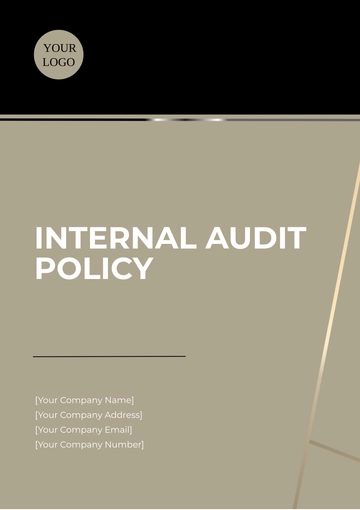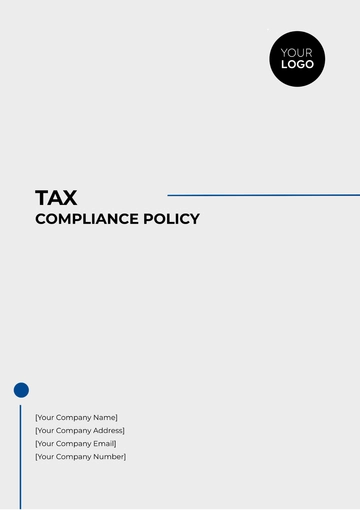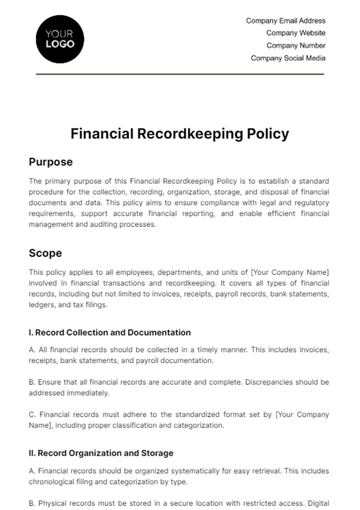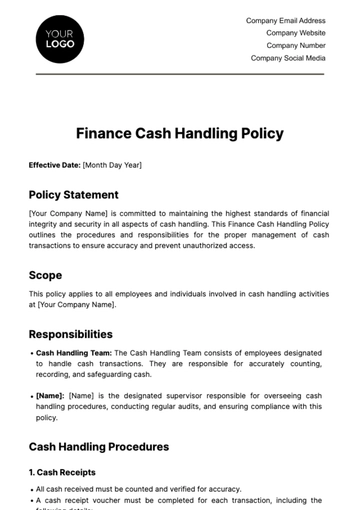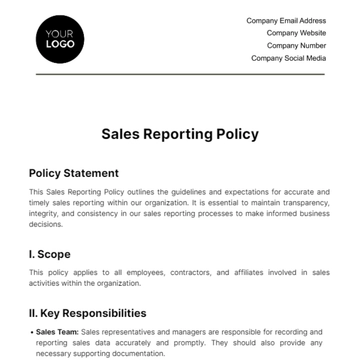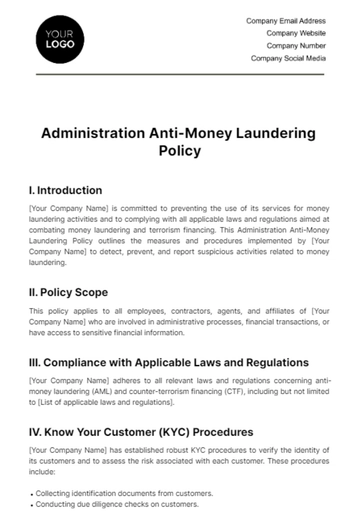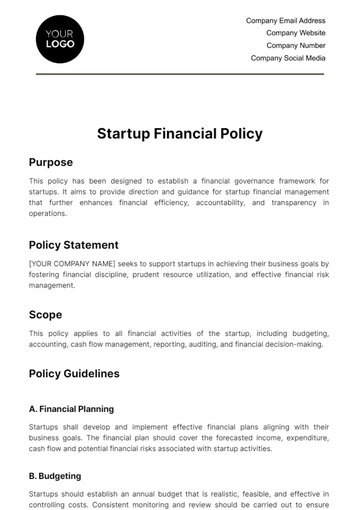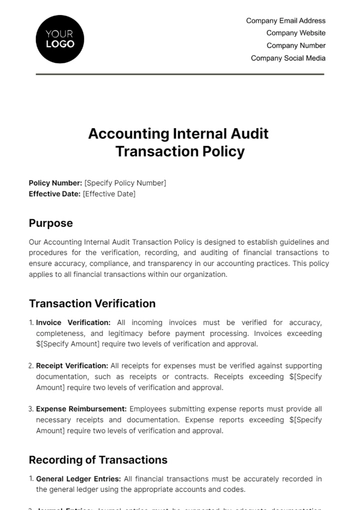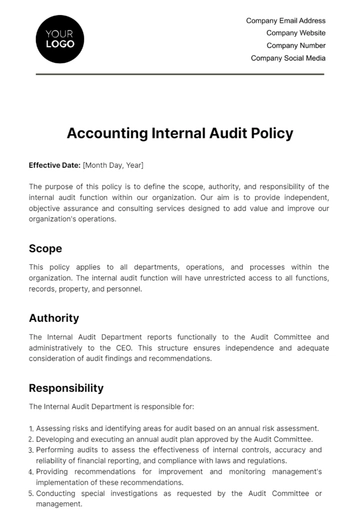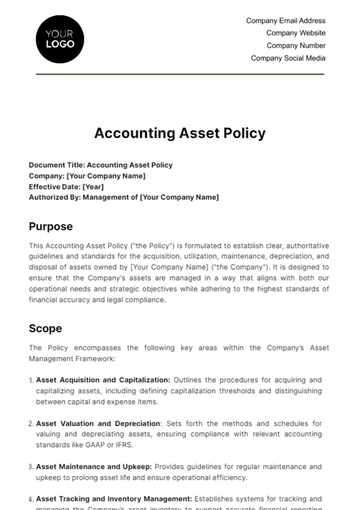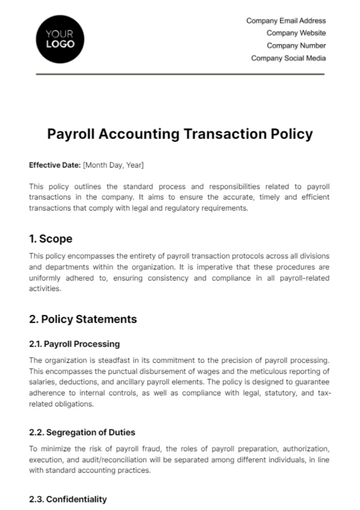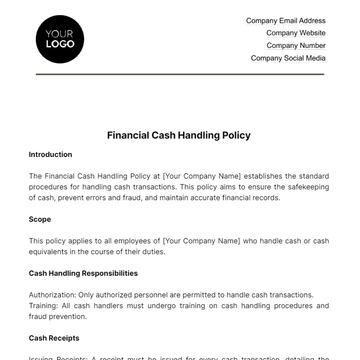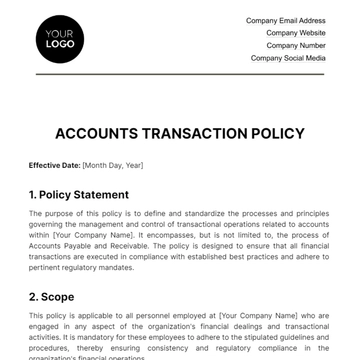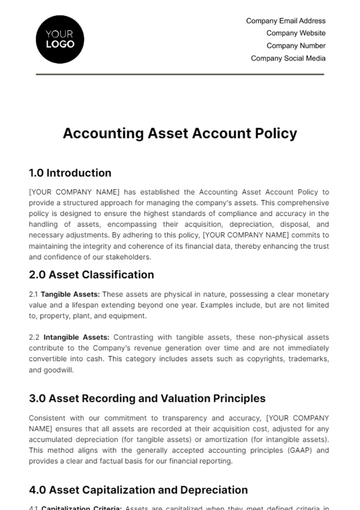Free Accounting Asset Policy
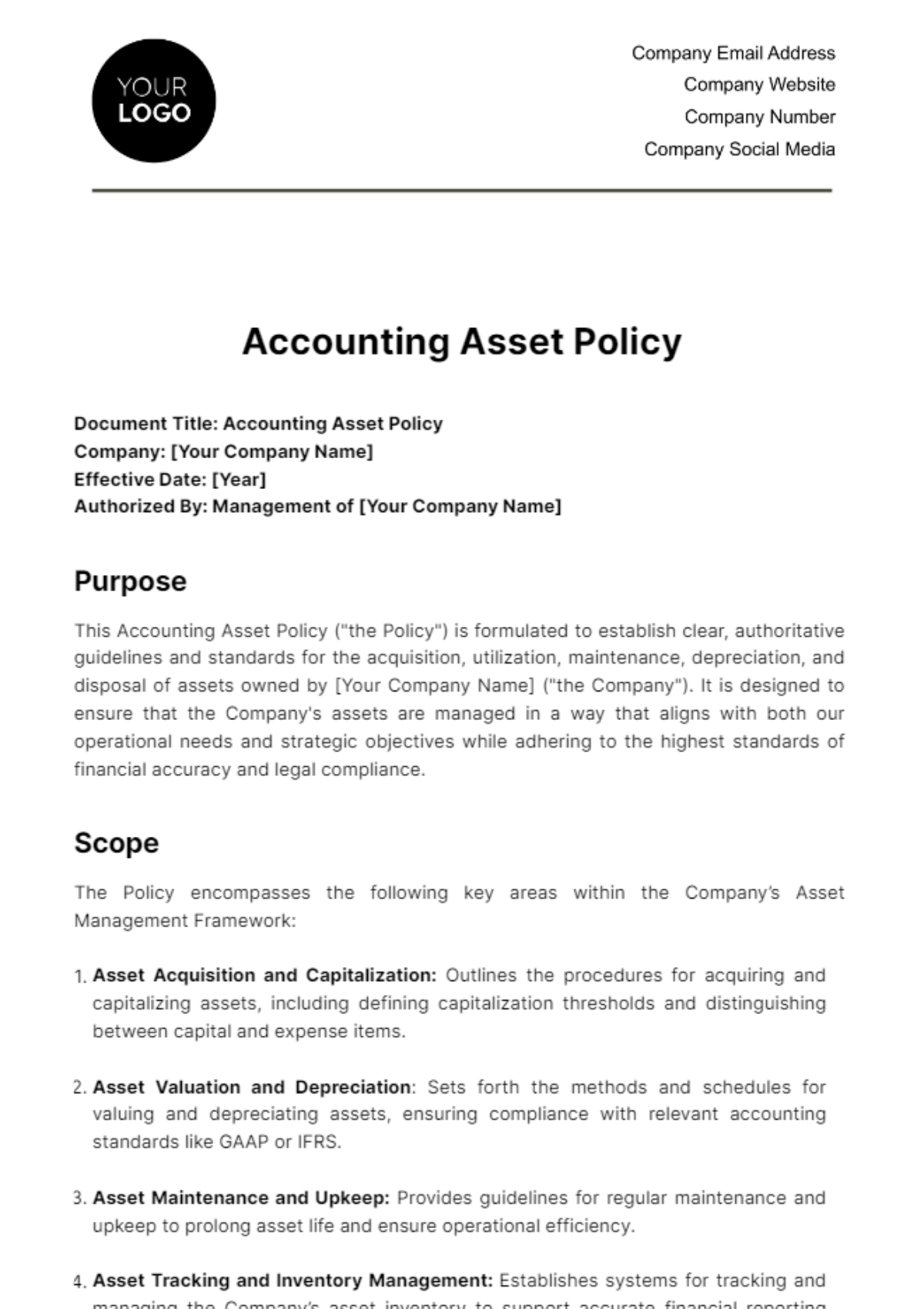
Document Title: Accounting Asset Policy
Company: [Your Company Name]
Effective Date: [Year]
Authorized By: Management of [Your Company Name]
Purpose
This Accounting Asset Policy ("the Policy") is formulated to establish clear, authoritative guidelines and standards for the acquisition, utilization, maintenance, depreciation, and disposal of assets owned by [Your Company Name] ("the Company"). It is designed to ensure that the Company's assets are managed in a way that aligns with both our operational needs and strategic objectives while adhering to the highest standards of financial accuracy and legal compliance.
Scope
The Policy encompasses the following key areas within the Company’s Asset Management Framework:
Asset Acquisition and Capitalization: Outlines the procedures for acquiring and capitalizing assets, including defining capitalization thresholds and distinguishing between capital and expense items.
Asset Valuation and Depreciation: Sets forth the methods and schedules for valuing and depreciating assets, ensuring compliance with relevant accounting standards like GAAP or IFRS.
Asset Maintenance and Upkeep: Provides guidelines for regular maintenance and upkeep to prolong asset life and ensure operational efficiency.
Asset Tracking and Inventory Management: Establishes systems for tracking and managing the Company’s asset inventory to support accurate financial reporting and optimal asset utilization.
Disposal and Retirement of Assets: Defines procedures for the disposal and retirement of assets, ensuring they align with the Company’s strategic goals and comply with regulatory standards.
Policy Details
Asset Acquisition and Capitalization
Thresholds and Procedures: Establishes clear thresholds for capitalizing assets and outlines the procedural steps for acquisition and capitalization.
Capital vs. Expense: Provides criteria for determining whether expenditures should be capitalized or treated as expenses.
Category | Detail | Criteria/Procedure | Purpose/Outcome |
|---|---|---|---|
Thresholds and Procedures | Establish thresholds for capitalizing assets | Assets over $5,000 are capitalized; below are expensed | Ensures consistent financial treatment of asset expenditures |
Capital vs. Expense | Criteria for capitalization vs. expense | Cost, useful life, and benefit period considered | Differentiates between capital assets and operational expenses |
Asset Valuation and Depreciation
Depreciation Methods: Details the acceptable methods of depreciation, including straight-line, declining balance, and units of production.
Compliance with Accounting Standards: Ensures that asset valuation and depreciation are in strict compliance with GAAP or IFRS standards.
Category | Detail | Method/Standard | Purpose/Outcome |
|---|---|---|---|
Depreciation Methods | Acceptable methods of depreciation | Straight-line, Declining Balance, Units of Production | Aligns depreciation with asset usage and revenue generation |
Compliance with Accounting Standards | Adherence to standards in asset valuation and depreciation | GAAP, IFRS | Ensures accuracy and compliance in financial reporting |
Asset Maintenance and Upkeep
Maintenance Schedules: Sets out schedules and procedures for regular maintenance of assets.
Upkeep Records: Requires detailed record-keeping of maintenance activities to ensure longevity and efficiency of assets.
Category | Detail | Procedure/Schedule | Purpose/Outcome |
|---|---|---|---|
Maintenance Schedules | Regular asset maintenance procedures | Periodic checks based on asset type and usage | Prolongs asset life and ensures efficiency |
Upkeep Records | Requirement for maintenance record-keeping | Detailed logs of all maintenance activities | Provides a historical record for asset condition assessment |
Asset Tracking and Inventory Management
Tracking Systems: Implements asset tracking systems for monitoring location, condition, and performance.
Inventory Accuracy: Ensures the accuracy and timeliness of asset inventory records.
Category | Detail | System/Approach | Purpose/Outcome |
|---|---|---|---|
Tracking Systems | Implement asset tracking systems | Use of digital tracking tools for location, condition monitoring | Efficient management of asset location and condition |
Inventory Accuracy | Ensuring accurate asset inventory records | Regular audits and updates to inventory records | Maintains up-to-date and accurate asset information |
Disposal and Retirement of Assets
Disposal Procedures: Outlines the steps for disposing of assets, including sale, trade-in, or scrapping.
Retirement Compliance: Ensures compliance with legal and accounting standards in the retirement of assets.
Category | Detail | Procedure/Compliance | Purpose/Outcome |
|---|---|---|---|
Disposal Procedures | Steps for asset disposal | Sale, trade-in, scrapping procedures outlined | Manages the end-of-life of assets effectively |
Retirement Compliance | Adherence to standards in asset retirement | Legal and accounting standards (GAAP, IFRS) | Ensures compliance in asset disposition |
Contact Information
For queries regarding this Policy, please contact:
Email: [Your Company Email]
Phone: [Your Company Number]
Amendments and Communication
This Policy is subject to revision and updates. Any amendments will be communicated to relevant parties in a timely manner. This Policy is duly authorized and enforced by the management of [Your Company Name], effective from [Year].
- 100% Customizable, free editor
- Access 1 Million+ Templates, photo’s & graphics
- Download or share as a template
- Click and replace photos, graphics, text, backgrounds
- Resize, crop, AI write & more
- Access advanced editor
Discover Template.net's Accounting Asset Policy Template, offering editable ease and customizable flexibility. Tailor your company's asset policies using our Ai Editor Tool, ensuring a perfect fit for your business needs. This policy template stands as an indispensable tool, streamlining your policy development with professional finesse. Embrace efficiency and clarity.
You may also like
- HR Policy
- Restaurant Policy
- Company Policy
- Accounting Policies and Procedures
- Website Policy
- Privacy Policy
- Safety Policy
- School Policy
- IT and Software Policy
- Law Firm Policy
- Construction Policy
- Interior Design Policy
- Travel Agency Policy
- Education Academic Policy
- Security Policy
- Real Estate Policy
- Expense Policy
- Software Policy

